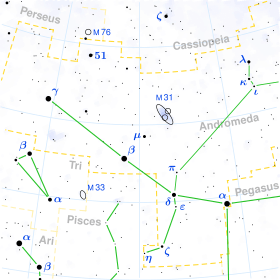Eta Andromedae
Eta Andromedae (Eta And, η Andromedae, η And) is a spectroscopic binary star in the constellation of Andromeda. It consists of two G-type subgiant or giant stars orbiting each other with a period of 115.7 days and has an overall apparent visual magnitude of approximately 4.403.[1][3]
 | |
| Observation data Epoch J2000.0 Equinox J2000.0 (ICRS) | |
|---|---|
| Constellation | Andromeda |
| Right ascension | 00h 57m 12.4000s[1] |
| Declination | +23° 25′ 03.533″[1] |
| Apparent magnitude (V) | 4.403[1] |
| Characteristics | |
| U−B color index | +0.69[2] |
| B−V color index | +0.94[2] |
| R−I color index | +0.48[2] |
| Component 1 | |
| Spectral type | G8III-IV[3] |
| Component 2 | |
| Spectral type | G8III-IV[3] |
| Astrometry | |
| Component 1 | |
| Radial velocity (Rv) | −10.3 ± 0.9[1] km/s |
| Proper motion (μ) | RA: −43.72[1] mas/yr Dec.: −46.06[1] mas/yr |
| Parallax (π) | 13.44 ± 0.75[1] mas |
| Distance | 240 ± 10 ly (74 ± 4 pc) |
| Absolute magnitude (MV) | 0.52 ± 0.06[3] |
| Component 2 | |
| Absolute magnitude (MV) | 1.07 ± 0.07[3] |
| Orbit[4] | |
| Period (P) | 115.72 ± 0.01 d |
| Semi-major axis (a) | 10.37 ± 0.03 mas |
| Eccentricity (e) | 0.006 ± 0.002 |
| Inclination (i) | 30.5 ± 0.4° |
| Longitude of the node (Ω) | 69.4 ± 0.5° |
| Periastron epoch (T) | 48013 ± 1 MJD |
| Argument of periastron (ω) (secondary) | 215 ± 4° |
| Details | |
| Component 1 | |
| Mass | 2.6 ± 0.35[5] M☉ |
| Luminosity (bolometric) | 65 ± 3[3] L☉ |
| Surface gravity (log g) | 2.8[3] cgs |
| Temperature | 4900[3] K |
| Age | 800 Million years |
| Component 2 | |
| Mass | 2.3 ± 0.31[5] M☉ |
| Luminosity (bolometric) | 39 ± 3[3] L☉ |
| Surface gravity (log g) | 3.0[3] cgs |
| Temperature | 4900[3] K |
| Other designations | |
| Database references | |
| SIMBAD | data |
History

Eta Andromedae was discovered to be a double-lined spectroscopic binary in a series of spectra taken in 1899 and 1900.[8] Its orbit was computed in 1946 from spectroscopic observations.[9] Because spectroscopy only reveals the radial velocity of a star towards or away from the viewer, such a computation does not determine all orbital elements. In observations made from 1990 to 1992, Eta Andromedae was resolved interferometrically by the Mark III Stellar Interferometer at Mount Wilson Observatory, California, United States. This allowed a more complete orbit to be computed and, in 1993, published.[3]
Naming
In Chinese, 奎宿 (Kuí Sù), meaning Legs (asterism), refers to an asterism consisting of η Andromedae, 65 Piscium, ζ Andromedae, ε Andromedae, δ Andromedae, π Andromedae, ν Andromedae, μ Andromedae, β Andromedae, σ Piscium, τ Piscium, 91 Piscium, υ Piscium, φ Piscium, χ Piscium and ψ¹ Piscium. Consequently, the Chinese name for η Andromedae itself is 奎宿一 (Kuí Sù yī, English: the First Star of Legs.)[10]
Visual companion
Eta Andromedae has a visual companion star of apparent visual magnitude 11.5, BD+22°153B, visible 129.2 arcseconds away.[7]
References
- "* eta And". SIMBAD. Centre de données astronomiques de Strasbourg. Retrieved August 23, 2008.
- HR 271, database entry, The Bright Star Catalogue, 5th Revised Ed. (Preliminary Version), D. Hoffleit and W. H. Warren, Jr., CDS ID V/50. Accessed on line August 23, 2008.
- The spectroscopic binary eta Andromedae: Determination of the orbit by optical interferometry, C. A. Hummel et al., Astronomical Journal 106, #6 (December 1993), pp. 2486–2492, Bibcode: 1993AJ....106.2486H, doi:10.1086/116816.
- Entry 00572+2325, Sixth Catalog of Orbits of Visual Binary Stars, United States Naval Observatory. Accessed on line August 27, 2008.
- Table 2, Resolved double-lined spectroscopic binaries: A neglected source of hypothesis-free parallaxes and stellar masses, D. Pourbaix, Astronomy and Astrophysics Supplement 145 (August 2000), pp. 215–222, Bibcode: 2000A&AS..145..215P.
- Entry 00572+2325, discoverer code MKT 2, components Aa, The Washington Double Star Catalog Archived April 12, 2008, at the Wayback Machine, United States Naval Observatory. Accessed on line August 27, 2008.
- Entry 00572+2325, discoverer code FOX 116, components AB, The Washington Double Star Catalog Archived April 12, 2008, at the Wayback Machine, United States Naval Observatory. Accessed on line August 23, 2008.
- A list of nine stars whose velocities in the line of sight are variable, W. W. Campbell and W. H. Wright, Astrophysical Journal 12 (November 1900), pp. 254–257, Bibcode: 1900ApJ....12..254C, doi:10.1086/140765.
- The Spectroscopic Binary η Andromedae, Katherine C. Gordon, Astrophysical Journal 103 (January 1946), pp. 13–15, Bibcode: 1946ApJ...103...13G.
- (in Chinese) AEEA (Activities of Exhibition and Education in Astronomy) 天文教育資訊網 2006 年 5 月 19 日